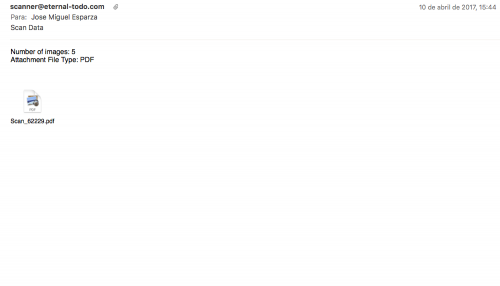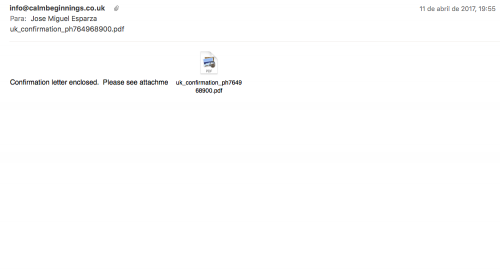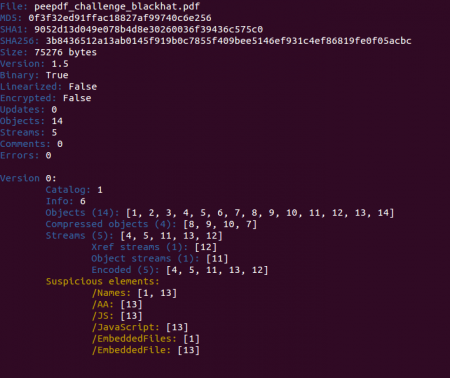During this month a Dridex spam campaign using PDF documents as infection vector was spotted. I also received a couple of e-mails in my personal inbox attaching the mentioned PDF files. One of them was using the typical “scanned data” theme (subject was “Scan data” and sender “scanner at eternal-todo.com”) and the other one was related to a confirmation letter (subject was “uk_confirmation_ph764968900.pdf” and the sender “info at calmbeginnings.co.uk”). None of them was really good in social engineering, just adding some words and the attachment.


Submitted by jesparza on Mon, 2017/04/24 - 01:24
Just before the summer I announced that the student Rohit Dua would dedicate his time to improve peepdf and add a scoring system to the output. This was possible thanks to Google and his Google Summer of Code (GSoC) program, where I presented several projects as a member of The Honeynet Project. A beta version was presented during Black Hat Europe Arsenal 2015 last November, where I introduced the new functionalities.
The scoring system has the goal of giving valuable advice about the maliciousness of the PDF file that’s being analyzed. The first step to accomplish this task is identifying the elements which permit to distinguish if a PDF file is malicious or not, like Javascript code, lonely objects, huge gaps between objects, detected vulnerabilities, etc. The next step is calculating a score out of these elements and test it with a large collection of malicious and not malicious PDF files in order to tweak it.
The scoring is based on different indicators like:
- Number of pages
- Number of stream filters
- Broken/Missing cross reference table
- Obfuscated elements: names, strings, Javascript code.
- Malformed elements: garbage bytes, missing tags…
- Encryption with default password
- Suspicious elements: Javascript, event triggers, actions, known vulns…
- Big streams and strings
- Objects not referenced from the Catalog
Submitted by jesparza on Sun, 2016/02/28 - 21:13
It has been a while since I wrote the last time here and since I presented at Botconf, but I wanted to share my slides here too. A couple of weks after the sad terrorist attacks in Paris, Botconf was held in the city of love. Way more secure than before and with lots of security controls which almost made me lose my return train, but it was worth it. Attending a security conference focused on cybercrime, malware, reverse engineering and intelligence is always a good plan :) I really recommend you attending Botconf this year in Lyon, you will not regret it ;)
My presentation was about Andromeda. This is the abstract:
Andromeda, also known as Gamarue by some Antivirus vendors, is a popular and modular bot active since 2011. It is normally used to spread additional malware, but sometimes, depending on the criminals, the main objective could be just stealing user credentials. After almost five years of life its development has not stopped. The people behind it keep maintaining it and adding functionalities, like new anti-analysis routines, changes in the communication encryption, new request formats, etc.
This talk will not give just details about the latest changes in the Andromeda binary and control panel, but it will also respond some interesting questions about this botnet. Which are the most popular versions used nowadays? Are most of the botnets spreading malware or just using its plugins? What are the most popular plugins? How and where is Andromeda sold? Who is selling it? What criminal groups are using Andromeda? It is not just a talk about malware reversing but about the whole Andromeda ecosystem.
Submitted by jesparza on Sun, 2016/02/07 - 23:09
One week before my demo at the Black Hat Arsenal I released a peepdf challenge. The idea was solving the challenge using just peepdf, of course ;) This post will tell you how to solve the challenge so if you want to try by yourself (you should!) STOP READING HERE! The PDF file can be downloaded from here and it is not harmful. No shellcodes, no exploits, no kitten killed. In summary, you can open it with no fear, but do it with a version of Adobe Reader prior to XI ;)
Let's start! :) This is what you see with the last version of peepdf:

In a quick look you can spot some Javascript code located in object 13 and also an embedded file in the same object. Checking the references to this object and some info about it we see that it is an embedded PDF file:
Submitted by jesparza on Wed, 2015/09/09 - 19:05
Two months ago Google announced that Google Code was slowly dying: no new projects can be created, it will be read only soon and in January 2016 the project will close definitely. peepdf was hosted there so it was time to move to another platform. The code is currently hosted at GitHub, way more active than Google Code:
https://github.com/jesparza/peepdf
If you are using peepdf you must update the tool because it is pointing to Google Code now. After executing “peepdf.py -u” the tool will point to GitHub and it will be able to be up to date with the latest commits. The peepdf Google Code page will also point to GitHub soon.
Another important announcement is that Rohit Dua will be the student who will work with peepdf this summer in the Google Summer of Code (GSoC). I initially presented three ideas to improve peepdf through The Honeynet Project:
Submitted by jesparza on Tue, 2015/05/05 - 21:34
After my last post about Andromeda different updates related to version 2.07 and 2.08 appeared. Mostly, Fortinet was talking about the version 2.7 features and the new anti-analysis tricks of version 2.08. After that, Kimberly was also mentioning version 2.09 in his blog but I have not seen too many details about the latest versions of Andromeda. This is a summary of the interesting details about the newer versions.
Andromeda versions
After version 2.08, the parameter used to send the bot version to the panel was removed from the POST request, so now it is a bit more difficult to distinguish between versions. An easy way to spot the different versions is taking a look at the request format strings:
-
id:%lu|bid:%lu|bv:%lu|sv:%lu|pa:%lu|la:%lu|ar:%lu (<=2.06)
-
id:%lu|bid:%lu|bv:%lu|os:%lu|la:%lu|rg:%lu (2.07/2.08)
-
id:%lu|bid:%lu|os:%lu|la:%lu|rg:%lu (2.09)
Submitted by jesparza on Fri, 2015/04/17 - 01:47
Some months ago I analyzed some PDF exploits that I received via SPAM mails. They contained the vulnerability CVE-2013-2729 leading to a ZeuS-P2P / Gameover sample. Back in June I received more PDF exploits, containing the same vulnerability, but in these cases it was a bit more difficult to extract the shellcode because the code was obfuscated. This is what we can see taking a look at the file account_doc~9345845757.pdf (9cd2118e1a61faf68c37b2fa89fb970c) with peepdf:
It seems that they used the same PDF exploit and they just added the obfuscation, because if we compare the peepdf output for the previous exploits we can see the same number of objects, same number of streams, same object ids, same id for the catalog, etc. After extracting the suspicious object (1) you can spot the shellcode easily, but some modifications are needed:
PPDF> object 1 > object1_output.txt
We can see two “images” encoded with Base64:
Submitted by jesparza on Thu, 2014/10/16 - 03:53
In mid-August I started receiving some emails from Yulia. She wanted me to take a look at her sweet ass:
I was not sure about it, but after receiving some more emails like this I took a look (I received the last one on the 10th of September). Then I found out that this was the beginning of a SmokeLoader campaign, I was really disappointed :( Out of spite, I started analyzing it ;p
These are some of the headers and the message body:
Date: Wed, 13 Aug 2014 12:55:56 -0400
From: "Yulia" <negligentjsd185@dialectologic.in>
Subject: My new photo
Hi it is Yulia fuck me ass at night. Look at my sweet ass on a photo I wait for you
I don't want to duplicate the information already published about this loader, so you can check the post published in July by StopMalvertising and what my colleague Michael Sandee said about it in 2012. Since then, SmokeLoader (known as Dofoil too) has modified the encryption to communicate with the C&C, added some extra plugins, etc.
After executing the binary you can easily spot that something is happening in your computer because you can see some strange POST requests to some known URLs. These URLs are extracted from the registry, opening the key Software\Microsoft\Windows\CurrentVersion\Uninstall and looking at the values of HelpLink and URLInfoAbout for the installed programs.
Submitted by jesparza on Sun, 2014/10/05 - 22:03
After some time without releasing any new version here is peepdf v0.3. It is not that I was not working in the project, but since the option to update the tool from the command line was released creating new versions became a secondary task. Besides this, since January 2014 Google removed the option to upload new downloads to the Google Code projects, so I had to figure out how to do it. From now on, all new releases will be hosted at eternal-todo.com, in the releases section.
The differences with version 0.2 are noticeable: new commands and features have been added, some libraries have been updated, detection for more vulnerabilities have been added, a lot of bug fixes, etc. This is the list of the most important changes (full changelog here):
Submitted by jesparza on Mon, 2014/06/16 - 19:38
I am used to receive SPAM emails containing zips and exes, even "PDF files" with double extension (.pdf.exe), but some days ago I received an email with a PDF file attached, without any .exe extension and it didn't look like a Viagra advertisement. Weird. I didn't have time to take a look at it, but the next day I received another one, with a different subject. The subject of the first email was “Invoice 454889 April” from Sue Mockridge (motherlandjjw949 at gmail.com) attaching “April invoice 819953.pdf” (eae0827f3801faa2a58b57850f8da9f5), and the second one “Image has been sent jesparza” from Evernote Service (message at evernote.com, but really protectoratesl9 at gmail.com) attaching “Agreemnet-81220097.pdf” (2a03ac24042fc35caa92c847638ca7c2).
At this point I was really curious so I took a look at them with peepdf.
Submitted by jesparza on Tue, 2014/05/20 - 23:51
One month ago I was trying to find a streaming site to watch a Spanish soccer match and I found futbolenvivoaldia.com. It was a redirection to the famous site Tarjeta Roja, but the interesting thing was that when I browsed the site with my mobile phone I saw the typical Antivirus scanner saying that my device was infected. Also, an app called “androidav_free.APK” (24f0a666a714e26c6c07ab407e37b112) was trying to be downloaded to my device.
The source of this fake page was one of the advertisement networks of the site tarjetaroja.eu, Mobicow. After some redirections and some tracking URLs this network was returning the following URL to the user's browser:
hxxp://cleanupnowonline10.biz/?u=Y0vbAf0fW9lIhVAxPi2nZQo
This page was loading Javascript code from here:
hxxp://cleanupnowonline10.biz/js/wapc.js
The code was obfuscated and this was the second stage of Javascript code:
Taking a look at the script content we can see that it contains all the functions necessary to show the fake infection page to the user. Also, we can see that the following URL was used to download the app:
hxxp://cleanupnowonline10.biz/apk.php
Submitted by jesparza on Mon, 2013/10/28 - 03:10
I was already missing these SPAM emails with some advice about my sexual life: “Your woman wants you to be the best lover”, “The greatest technique to gratify your lady”, etc. I was getting upset about this, I needed some help...;p
So finally I am receiving a lot of these again. After visiting the link (hxxp://goozix.com/its.html) we can see a redirection to a page to buy Viagra and other “medicines”. But also there is some malicious Javascript code hidden there. The result of the deobfuscation contains code to create a cookie (“visited_uq=55”) and also an iframe to load the URL hxxp://gylaqim.com/exit.php. This domain, created on the 21st of September, resolves each time to a different IP and has a history of more than 400 IPs. It has 6 authoritative DNS servers, ns*.gylaqim.com, also resolving to multiple IPs.
Depending on the server which is responding after visiting hxxp://gylaqim.com/exit.php we will be redirected to another initial page - with another redirection to a Viagra site plus malicious Javascript code - or to the actual exploit kit.
The initial pages seen until the moment are the following:
hxxp://178.170.104.124/destruction.html
hxxp://178.170.104.124/seed.html
hxxp://actes-lyon.org/true.html
hxxp://aybabtu.ru/express.html
hxxp://brave.net.nz/ocean.html
hxxp://goozix.com/its.html
hxxp://moniwild.sakura.ne.jp/average.html
hxxp://rodinr.511.com1.ru/angle.html
hxxp://southeasterntrains-fail.com/somewhere.html
hxxp://toys-store.net/dawn.html
Submitted by jesparza on Tue, 2013/10/08 - 00:11
More than 2 years ago (that's a lot of time!) I published a simple Python script to monitor a Twitter account using Tweepy: basic account information, inactive friends and new/lost followers. But this script stopped working some time ago because Twitter updated its API to version 1.1. This update made obligatory using authentication to make any request and they also modified the request limits. Before the update, there was a limit of 150/350 requests per hour, depending on whether the request was authenticated or not, but now these limits are per request type and per 15 minutes. For example, to get a list of friends you can make a maximum of 15 requests per quarter of hour, but you can make other 15 to get a list of followers. If someone is late (like me) with the new API here you can find the full changelog.
Before starting to modify the code I had to update the Tweepy version too (2.1). The best and easiest way is using pip:
$ pip install tweepy
Submitted by jesparza on Sun, 2013/09/08 - 14:56

|